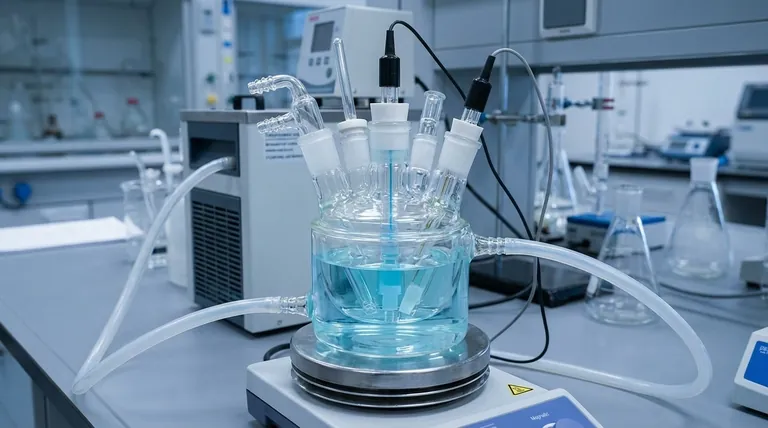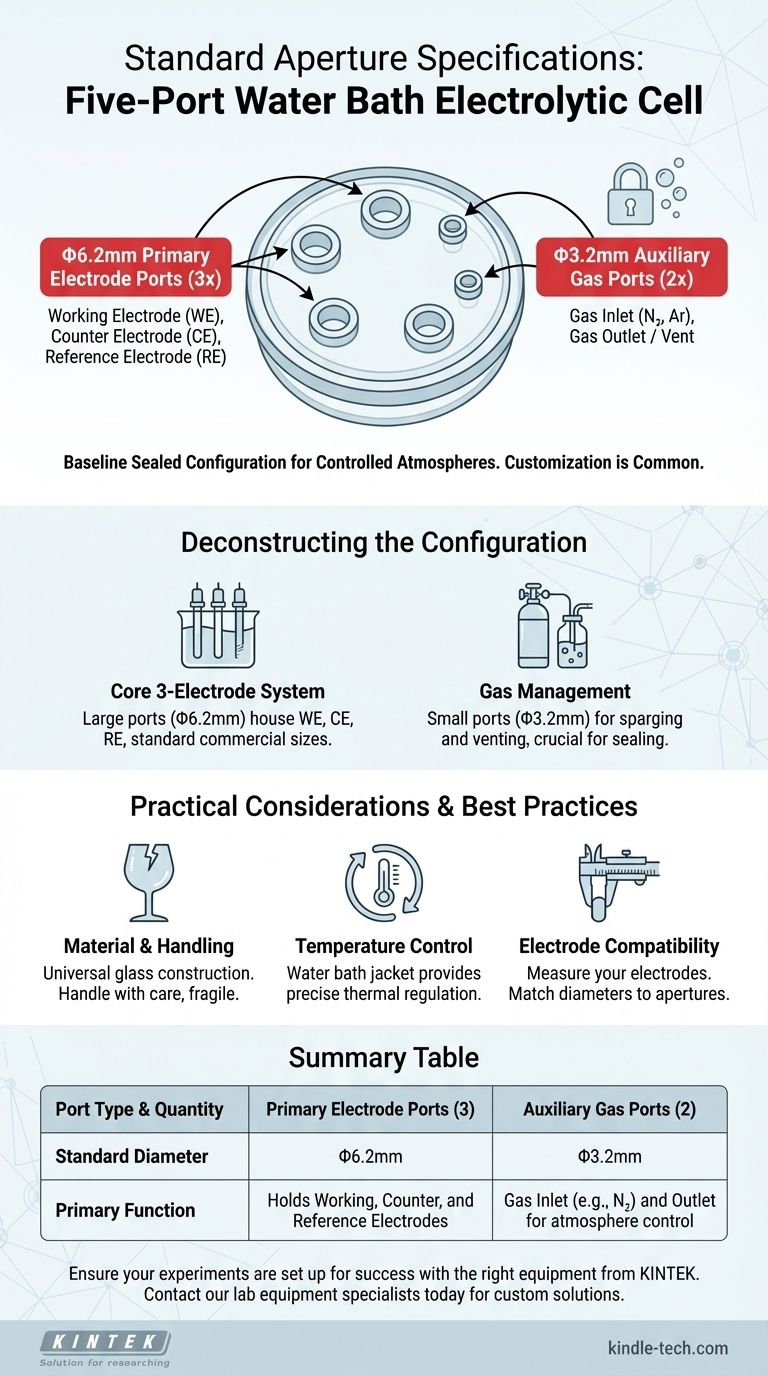For a standard five-port water bath electrolytic cell, the most common sealed configuration includes three larger apertures with a diameter of Φ6.2mm and two smaller apertures with a diameter of Φ3.2mm. These specifications are designed to accommodate a typical three-electrode system along with necessary gas lines for atmospheric control. However, it is critical to note that customization is widely available and often necessary.
The concept of a "standard" configuration is a baseline for general-purpose experiments. The true standard is functionality: providing dedicated ports for the working, counter, and reference electrodes, plus essential gas inlets and outlets, while allowing for extensive customization.

Deconstructing the Five-Port Configuration
A five-port cell is designed to provide comprehensive control over the electrochemical environment. Each port serves a specific, essential function that enables precise and repeatable experiments.
The Primary Electrode Ports (Φ6.2mm)
The three larger ports are the workhorses of the cell, designed to house the core components of a three-electrode system.
This typically includes the Working Electrode (WE), the Counter Electrode (CE), and the Reference Electrode (RE). The 6.2mm diameter is a common size for standard commercial electrodes.
The Auxiliary Ports (Φ3.2mm)
The two smaller ports are typically reserved for gas management.
One port serves as a gas inlet for sparging the solution with an inert gas like nitrogen or argon to remove dissolved oxygen. The other serves as a gas outlet or vent.
The Role of Sealing
The five-port design is most common in sealed cell systems. A sealed environment is crucial for experiments that are sensitive to atmospheric oxygen or require precise control over the headspace gas composition.
"Standard" as a Starting Point
While the 3x(Φ6.2mm) + 2x(Φ3.2mm) configuration is a common baseline, it is essential to treat it as a starting point rather than an absolute rule. The utility of an electrolytic cell is defined by its adaptability.
Why Customization is Common
Your specific experimental needs may demand a different configuration. For example, you might need a larger port for a rotating disk electrode (RDE) or an additional port for a temperature probe or salt bridge.
Verifying Supplier Specifications
Suppliers may have slightly different "standard" offerings. For instance, some non-sealed versions might only feature three Φ6.2mm openings. Always verify the exact specifications with the manufacturer before purchasing to ensure compatibility with your existing equipment.
Practical Considerations and Best Practices
Understanding the physical and functional aspects of the cell will prevent costly mistakes and experimental errors.
Material and Handling
These cells are almost universally made of glass. While excellent for chemical inertness and visibility, glass is fragile and must be handled with care to prevent breakage, especially when inserting or removing electrodes and stoppers.
Temperature Control
The "water bath" feature is integral to this cell's design. It allows for a heat transfer fluid to be circulated through an outer jacket, providing precise temperature control for your experiment, which is critical for many electrochemical reactions.
Electrode Compatibility
Before ordering a cell, measure the diameters of your existing electrodes and probes. Ensuring they match the aperture specifications is the single most important step to guarantee a functional setup upon arrival.
Making the Right Choice for Your Goal
The ideal cell configuration depends entirely on your experimental objective. Use the following guidelines to make an informed decision.
- If your primary focus is general voltammetry in a controlled atmosphere: The standard sealed five-port configuration (3x 6.2mm, 2x 3.2mm) is an excellent and versatile choice.
- If your primary focus is using specialized equipment like an RDE or spectroelectrochemical probe: You must confirm the required port diameter for your equipment and order a custom-configured cell lid.
- If your primary focus is replicating a published experiment: Carefully review the paper's experimental methods section and contact the supplier to match the exact cell specifications used by the authors.
Ultimately, selecting the correct electrolytic cell is about choosing the right tool to ensure the precision and repeatability of your results.
Summary Table:
| Port Type | Quantity | Standard Diameter | Primary Function |
|---|---|---|---|
| Primary Electrode Ports | 3 | Φ6.2mm | Holds Working, Counter, and Reference Electrodes |
| Auxiliary Gas Ports | 2 | Φ3.2mm | Gas Inlet (e.g., N₂) and Outlet for atmosphere control |
Ensure your electrochemical experiments are set up for success with the right equipment from KINTEK.
Whether you need a standard five-port water bath electrolytic cell or a custom-configured solution for specialized electrodes (like RDEs) or probes, KINTEK has the expertise to support your laboratory's unique requirements. Our high-quality glass cells provide the precision and durability needed for reliable, repeatable results.
Contact our lab equipment specialists today to discuss your specific cell configuration and get a quote tailored to your research goals.
Visual Guide

Related Products
- Double Layer Five-Port Water Bath Electrolytic Electrochemical Cell
- Electrolytic Electrochemical Cell with Five-Port
- Multifunctional Electrolytic Electrochemical Cell Water Bath Single Layer Double Layer
- Double-Layer Water Bath Electrolytic Electrochemical Cell
- H-Type Double-Layer Optical Electrolytic Electrochemical Cell with Water Bath
People Also Ask
- What precautions should be taken regarding temperature control for the electrolytic cell? Ensure Safe & Accurate Electrolysis
- How should the electrolytic cell be secured on the stand during an experiment? A Step-by-Step Guide for Stability
- How should a double-layer water-bath electrolytic cell be operated? A Step-by-Step Guide for Reliable Results
- How should faults with the electrolytic cell be handled? A Guide to Safe Diagnosis and Repair
- When is chemical cleaning necessary for an electrolytic cell, and how should it be performed? A Guide to Removing Stubborn Deposits



















